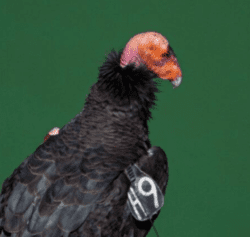edZOOcating: California Condor Conservation Story
So, What’s the Problem?
In the mid-1900s, California condors were disappearing rapidly from the wild and by the 1960s, they were placed on the Endangered Species List. Their populations were being threatened by…
1
Lead Poisoning
This was the largest issue the condors face. When hunters make a kill of any game animal, they often take the meat and leave the organs and other non-desirable body parts, which make a nice easy meal for condors. Lead ammunition is inexpensive and commonly used in game hunting. When the bullets hit the animal, they explode, leaving small lead fragments in all different parts of the body, including the remains left for the condors.
2
Pollution
From insecticides to microplastics, as the human population expanded, pollution in the environment had a greater and greater impact on California condors. DDT, which is a synthetic insecticide made popular in the mid-1900s, took a toll on condor populations and many other species as it was dumped into the environment. Condor eggs became fragile and successful incubation happened infrequently. On top of that, little bits of garbage, particularly plastic, have made their way into all parts of the environment and are commonly ingested by adults, or even accidentally fed to chicks.
3
Habitat Loss
As humans continued to expand and take over previously-wild spaces, we built tall structures and put up power lines, we built roads and separated ecosystems. Condors require large, open spaces, something that is becoming more challenging for them to find. Collisions with powerlines and buildings became more common. Condors exploring and landing in populated areas led to more poaching opportunities. The prey base became depleted or poisoned and condor populations continued to decline.
RECOVERY PROGRAM
From 1983 to 1987, all of the remaining California condors were collected from the wild and brought to the San Diego Zoo and the Las Angeles Zoo to begin a captive breeding program
Wildlife biologists and a team of scientists had to quickly learn how to successfully encourage breeding among the captive condors. Not without a lot of trial and error, the first captive condor was born in 1988
Condors are very slow breeders, only having one single chick every year or two. Reproduction in captivity could be accelerated by removing the egg once it had been laid, encouraging them to lay again
Eggs that remained were raised by the mother condor. Eggs that were removed were incubated and raised by human caretakers, though caretakers used a condor puppet to ensure the chicks would not imprint on people
The captive breeding population of the condors was becoming more and more successful with breeding programs expanding to other facilities, such as the Oregon Zoo and the Peregrine Fund
In January of 1992, the first captive-born condor was released back into the wild in California followed by Arizona and Mexico. Since then, every single bird has been tagged and closely monitored
Conservation Series
Explore conservation challenges, strategies, and successes happening in ecosystems all around the world! Discover new ways conservationists are thinking outside of the box and how you and your students can make a difference.




